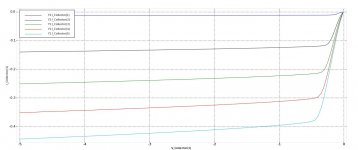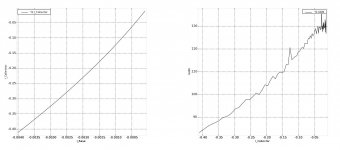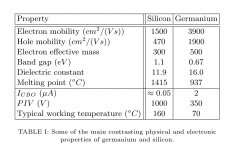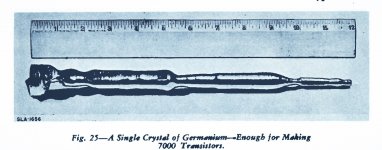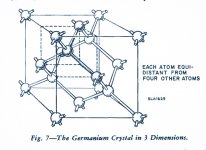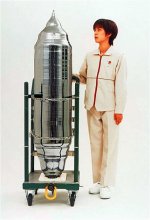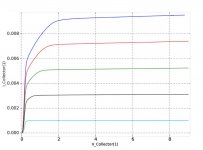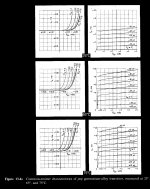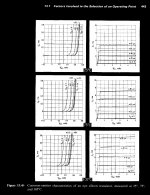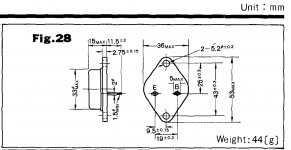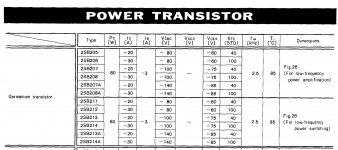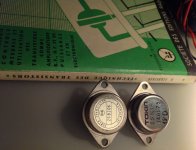After watching the NP interview where he discussed his interest in Germanium, I ordered some parts. The parts have begun to tricke in.
This is a 2SB63 power device. It looks to me to have a built-in compressor. Where a MOSFET is a square law device, this Germanium BJT looks like a 1/X law device.
This is a 2SB63 power device. It looks to me to have a built-in compressor. Where a MOSFET is a square law device, this Germanium BJT looks like a 1/X law device.
Attachments
http://www.n4trb.com/AmateurRadio/SemiconductorHistory/GE_Transistor_Manual_2nd_Edition.pdf
https://ia800106.us.archive.org/21/items/Germanium/Germanium.pdf
Back to the future from 50´s
https://ia800106.us.archive.org/21/items/Germanium/Germanium.pdf
Back to the future from 50´s
Attachments
After watching the NP interview where he discussed his interest in Germanium, I ordered some parts. The parts have begun to tricke in.
This is a 2SB63 power device. It looks to me to have a built-in compressor. Where a MOSFET is a square law device, this Germanium BJT looks like a 1/X law device.
Standard BJT curves. Early effect evident in the first plot, gain droop at higher currents in the second. Its traditional for that second plot to be log-log scaled. Both plots are upside down (!)
The only blatant differences you'll see with common Ge BJTs compared to Si is the lower bandgap voltage and the much higher leakage currents, the physics is the same.
Careful soldering Ge devices, they don't like any kind of temperature.
Standard BJT curves. Early effect evident in the first plot, gain droop at higher currents in the second. Its traditional for that second plot to be log-log scaled. Both plots are upside down (!)
The only blatant differences you'll see with common Ge BJTs compared to Si is the lower bandgap voltage and the much higher leakage currents, the physics is the same.
Careful soldering Ge devices, they don't like any kind of temperature.
Thank you for the info and the soldering advice. I will use a spring loaded scissor clamp heatsink on the transistor leads.
More measurements to take on more devices.
I will curve trace and compare some power silicon BJTs.
..I ordered some parts..
Are 2SB206 included in Device's Under Test ?
Are 2SB206 included in Device's Under Test ?
They are on the list to order. I have already corresponded with the seller and will order them. Nothing is shipping from China/Hong Kong until later in February. Some LU1014D are stuck in Hong Kong on the way to me.
I have ordered quite a few different Germanium devices. Just getting started to measure them and try to understand them. I have already destroyed one. The small signal devices appear to be easy to make into a dead fuse.
So far, I like what I see. No devices yet have the horrible quasi-saturation behavior I saw in the KSC3503E that I used in a preamp/driver project.
The harder you drive the Germanium devices, the more the linear region expands.
Ge want precise and controlled bias point with protection against thermal runaway.. I have already destroyed one. The small signal devices appear to be easy to make into a dead fuse..
says legend writen by semiconductor Druids in Germanium Valley actually renamed Silicon
Attachments
Ge want precise and controlled bias point with protection against thermal runaway
says legend writen by semiconductor Druids in Germanium Valley actually renamed Silicon
And this is silicon, enough to make 10^12 transistors (or even more).
Attachments
> semiconductor Druids in Germanium Valley actually renamed Silicon
Germanium technology was developed ALL over. Arguably the Russians did more than US, EU, or Japan.
Clean Passivated Silicon is mostly from Andrew Grove's work, the dull parts recited in Physics and Technology of Semiconductor Devices (1967); the interesting parts leaked as people left Fairchild and Intel.
Germanium technology was developed ALL over. Arguably the Russians did more than US, EU, or Japan.
Clean Passivated Silicon is mostly from Andrew Grove's work, the dull parts recited in Physics and Technology of Semiconductor Devices (1967); the interesting parts leaked as people left Fairchild and Intel.
Thanks for the contributions, one and all.
Since our muse, NP, is interested in Germanium, I thought I would play along. I have access to modern test equipment. The investigations can possibly be fruitful.
I was impressed by something that NP said in one of his videos. He looks for devices that are more linear before degeneration. A corollary to that could be looking for devices that behave better at boundary conditions.
Since our muse, NP, is interested in Germanium, I thought I would play along. I have access to modern test equipment. The investigations can possibly be fruitful.
I was impressed by something that NP said in one of his videos. He looks for devices that are more linear before degeneration. A corollary to that could be looking for devices that behave better at boundary conditions.
KSC1845
KSC1845 Family of curves. I set this up to show the pertinent info for biasing at at 5mA class A and show the behavior at clipping.
My experience with a KSC3503E having a similar shaped family of curves is that clipping is ugly.
If this device is cascoded at 5V or more, it is nicely linear.
So far, all of the Germanium devices that I have run through the curve tracer have none of the quasi-saturation gain compression near clipping.
KSC1845 Family of curves. I set this up to show the pertinent info for biasing at at 5mA class A and show the behavior at clipping.
My experience with a KSC3503E having a similar shaped family of curves is that clipping is ugly.
If this device is cascoded at 5V or more, it is nicely linear.
So far, all of the Germanium devices that I have run through the curve tracer have none of the quasi-saturation gain compression near clipping.
Attachments
I have some piece of 2sb214's , i hope they will also be tested..
If you have a datasheet with curves, feel free to post it here.
I do not have any of these devices. If you want to send one or two to me, I will be happy to run them trough the curve tracer and post the results here.
Last days study 13.6 chapter page 463 who explain special bias circuit for Germanium transistors.
Now Diyers can get his own digital book , document is classified in public domain
Electronic Principles : Paul E. Gray & Campbell L. Searle : Free Download, Borrow, and Streaming : Internet Archive
Now Diyers can get his own digital book , document is classified in public domain

Electronic Principles : Paul E. Gray & Campbell L. Searle : Free Download, Borrow, and Streaming : Internet Archive
Attachments
Extract  Have a nice day
Have a nice day
Attachments
-
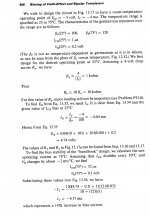 46F66B0F-8D6F-4DD7-B161-A13D1F0D7A05.JPG375.4 KB · Views: 301
46F66B0F-8D6F-4DD7-B161-A13D1F0D7A05.JPG375.4 KB · Views: 301 -
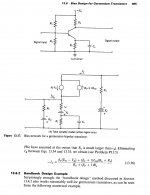 018876F6-A4D1-446E-B1C2-299481F49B04.JPG252.5 KB · Views: 336
018876F6-A4D1-446E-B1C2-299481F49B04.JPG252.5 KB · Views: 336 -
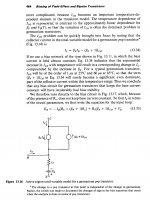 A64FE3DB-B273-4C3A-A760-5DA821B948B3.JPG483 KB · Views: 229
A64FE3DB-B273-4C3A-A760-5DA821B948B3.JPG483 KB · Views: 229 -
 4613C920-9F11-4B40-96E5-A737F8BA605B.JPG262.9 KB · Views: 898
4613C920-9F11-4B40-96E5-A737F8BA605B.JPG262.9 KB · Views: 898 -
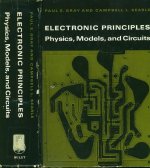 A6F476D5-780A-431C-80E7-03BCD760C812.JPG129.3 KB · Views: 937
A6F476D5-780A-431C-80E7-03BCD760C812.JPG129.3 KB · Views: 937 -
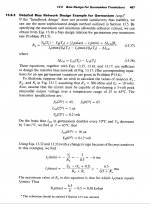 1A763FF5-0A83-4445-93F6-C1F5D5912228.JPG455.8 KB · Views: 179
1A763FF5-0A83-4445-93F6-C1F5D5912228.JPG455.8 KB · Views: 179 -
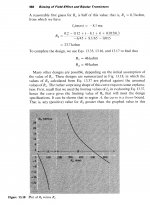 4D82E9CE-B6DE-449B-A65B-EDC577AAC5C6.JPG639.9 KB · Views: 165
4D82E9CE-B6DE-449B-A65B-EDC577AAC5C6.JPG639.9 KB · Views: 165 -
 30A390E2-859C-4CAE-8ED5-CD84E1E11155.JPG223.6 KB · Views: 169
30A390E2-859C-4CAE-8ED5-CD84E1E11155.JPG223.6 KB · Views: 169 -
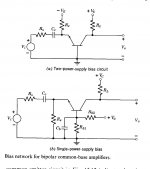 480EADED-7959-42A4-8F4B-25E9E4DAECA5.JPG154.3 KB · Views: 252
480EADED-7959-42A4-8F4B-25E9E4DAECA5.JPG154.3 KB · Views: 252
Cool Woofertester You received themlet's start Germanium curves show!
Datasheet say 2SB206 power dissipation ~ 80Watt's.
Strange because transistor package size is similar to big 300Watt's 2SK180.
That is an interesting point. I have bought different germanium power devices that do have data. They all seem to be low power rated compared to similar size silicon devices.
I think that it may be because they are junction devices. Just my opinion based on reading how they were manufactured.
- Home
- Amplifiers
- Pass Labs
- Germanium investigations
